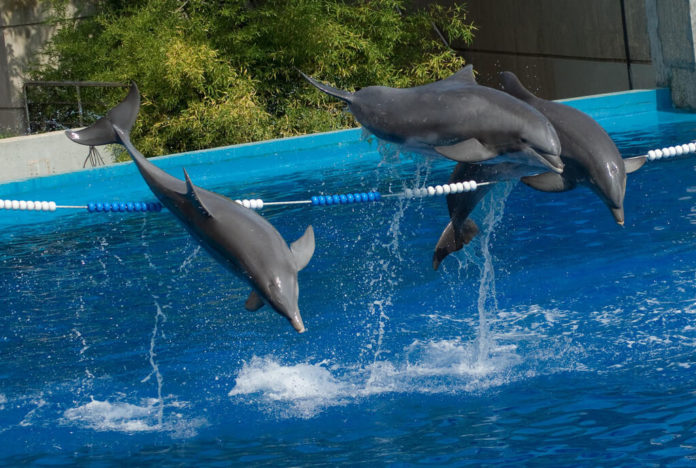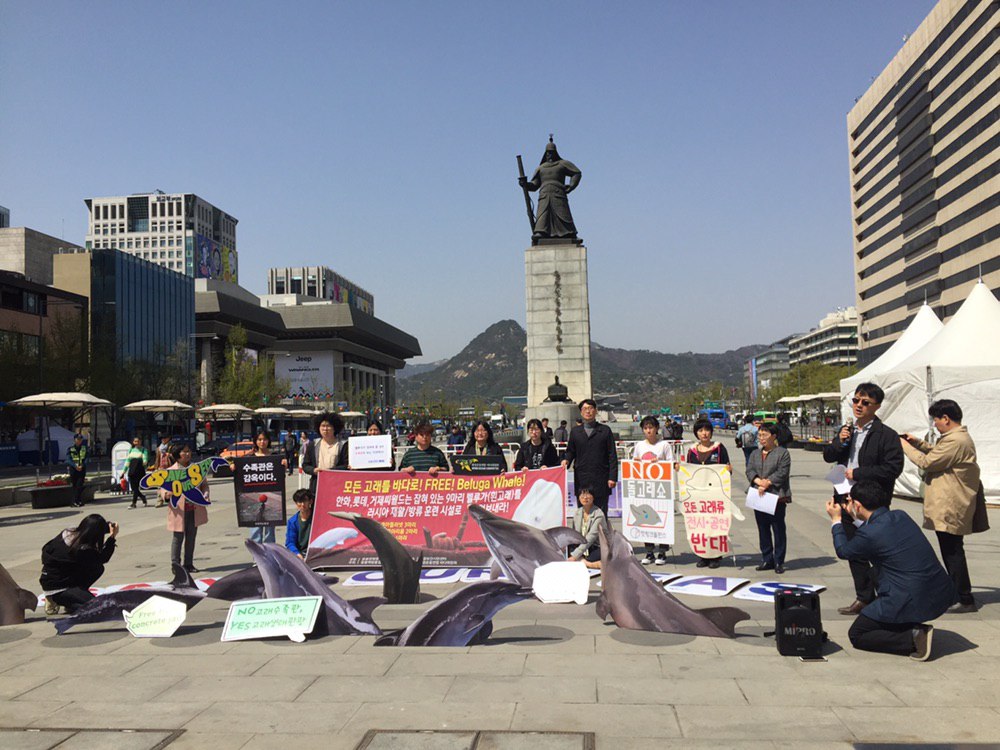인도에서 돌고래 수족관 건립이 정부에 의해 금지되었다는 소식이 전해졌습니다. 힌두스탄 타임즈 5월 8일치 기사에 의하면 인도 환경부가 동물 학대를 우려해서 돌핀파크 건립을 불허했다는 것입니다.
이와 관련한 여러 기사들을 보면 델리 인근의 위성도시 노이다, 케랄라 주 코치, 뭄바이 이렇게 세 군데에 돌고래 공연장과 돌고래 체험 프로그램장 건립을 허가해달라는 요청이 접수되었는데, 이들이 모두 불허되었답니다.
관련해서 인도 중앙정부의 환경삼림부 장관이 “영국, 브라질, 칠레에서는 돌고래 수족관이 금지되어 있다. 동물 학대를 우려해서 인도에서 돌고래 수족관(dolphinarium)은 앞으로 허가하지 않을 것이다” 라고 힌두스탄 타임즈와의 인터뷰에서 밝혔습니다.
이미 인도 환경삼림부 산하 동물복지국(AWBI, The Animal Welfare Board of India)은 지난 1월에 인도 전역에 걸쳐 고래류 수족관 개관을 허가하지 말 것을 각 정부기구에 주문했습니다. 그 이유는 수족관에 갇힌 해양포유동물들이 건강에 커다란 위협을 받고 있으며, 이에 따라 자연 상태의 해양포유류에 비해 너무나 일찍 죽어버리기 때문이라고 합니다.
인도에서는 유일한 돌고래 공연장이 1990년대에 남부 첸나이에 있었는데, 그곳의 돌고래들이 오래 살지 못하고 곧 죽어버렸답니다. 그래서 돌고래들이 모두 죽자 새로운 돌고래들을 수입하지 않고 자연스럽게 돌고래 공연장이 폐쇄되었다고 합니다.
이미 인도에서는 동물학대금지법이 1960년에 제정이 되어 있고요, 뒤이어 제정된 야생동물보호법 등에 따라 포유 동물을 비롯해 조류 등을 동원해 동물쇼나 서커스를 벌이는 것을 금지해왔다고 합니다. 이에 따라 자연스레 인도에서는 동물쇼가 사라지게 되었다고 해요.
이번 인도 환경부의 돌고래 공연장 불허는 상식적인 것인 조치입니다. 수족관에 사는 고래류가 원래 수명보다 2분의1에서 10분1밖에 살지 못한다는 것은 잘 알려져 있습니다. 하루에 백km 이상을 헤엄치며 살던 고래들이 사방 10미터도 되지 않은 좁은 곳에 갇혀 있으면 얼마나 답답할까요? 그래서 인도에서는 앞으로 많은 나라들의 선례를 따라 고래류를 전시, 공연하는 수족관은 짓지 않기로 한 것입니다. 그리고 결국 환경부장관이 직접 수족관 건립을 불허하겠다고 공표한 것이죠.
한국은 인도보다도 환경의식 수준이 낮네요. 돌고래 체험 프로그램이나 돌고래 공연장은 모두 멸종위기 해양동물인 돌고래를 잡아다 좁은 수조에 가두고 억지로 동작을 시킨다는 점에서 비윤리적이지요. 게다가 고래류는 수족관 번식도 되지 않아서 모두 자연에서 포획해야 합니다. 안그래도 생태계가 망가지고 있는데, 멸종위기 고래류를 잡아들이는 돌고래 쇼장이나 체험장 같은 곳은 아예 짓지 말아야겠어요. 환경파괴, 동물학대를 멈춥시다!

관련 기사 India bans captive dolphin shows, says they should be considered ‘non-human’ people
Non-human people the world over are cheering India’s decision to ban captive dolphin shows.
Citing tireless scientific research that has forced scientists to conclude that cetaceans – dolphins, whales and porpoises – rival our own species in terms of intelligence, self consciousness and culture, the Indian Ministry of the Environment and Forests released a statement advising state governments to reject any proposals for establishing dolphinariums.
The Declaration of Rights for Cetaceans, signed by ethicists and the world’s leading dolphin and whale researchers, calls for cetaceans to be considered “non-human people” and says they should have the right to life, freedom and not to be considered property.
India has embraced the call for a widening of the narrow designation of beings deserving of life, liberty and happiness beyond that of only humans.
It tops the list as the most important country to ban for-profit slavery of its national animal, joining Costa Rica (where sport hunting and wild animals in circuses are also banned ), Hungary and Chile.
As a top tourist destination which could stand to rake in hefty fees for swim-with-dolphins-type tourist attractions, India intends to make a statement that we need to start making serious adjustments to our relationships with the rest of the non-human people in our world if we have any intention of living up to the created-in-God’s-image ego we have inflated ourselves with.
“This is a huge win for dolphins,” former dolphin trainer and current director of Earth Island Institute’s Dolphin Project, Ric O’Barry said. “Not only has the Indian government spoken out against cruelty, they have contributed to an emerging and vital dialogue about the ways we think about dolphins – as thinking, feeling beings rather than pieces of property to make money off of.”
And a good number of unthinking, unfeeling beings are living the good life off the misery of these beautiful creatures.
There are more than 500 dolphins, orcas and other cetaceans being held in small, sterile, cement enclosures in the United States, according to Born Free USA.
And these are the “lucky” ones. Many of the captive dolphins around the world are refugees from the infamous dolphin slaughter exposed in the Oscar award-winning documentary, The Cove.
Amid the chaos of the slaughter, as family members are drug one-by-one under the tarp to be stabbed to death, young dolphins with no blemishes are selected by dolphin trainers – who have paid up to $300,000 each – and plucked out of the blood-red water of the cove to live out the rest of their often unnaturally short lives as property whose only purpose is to entertain tourists, amassing no more worth than a roller coaster.
It’s easy to understand why those making about $125 a pop for one 30-minute swim with non-human people who can’t complain or escape would be motivated to take part in such obvious injustice, but the millions of people who patronize the Sea Worlds of the world are the most frustrating mystery.
Our minds give little resistance against something we want to believe, something that enables a certain desired behavior, in this case, allowing slaves to entertain us and our children.
We want to believe that we care about animals, so we want to believe that when we are exploiting them, we are being nice at the same time.
Our greatest historical flaw – as far as animals might rank it – is our lack of imagination.
Are we so conditioned to seeing animals confined and unhappy that we can’t imagine that cetaceans who can swim hundreds of miles a day, live in family groups their whole lives that care for other injured and elderly members and spend only 20 percent of their time at the surface of the sea could not possibly be overjoyed to be torn from their families and the ocean and made to do tricks for food?
The only “education” these venues provide is a suspension of imagination.
Where imagination lacks, so follows empathy, ensuring little hope for the kind of world we all pretend to really want.
India has its flaws, but when big decisions are made in the name of protecting the innocent that challenge our maniac obsession with making money, we know we’re on the right track to shaping that world we are so painfully capable of building.
For more information on dolphins in captivity and the slaughter in Taiji, check out Save Japan Dolphins, a project of the Earth Island Institute.
관련 기사 : Fearing cruelty, environment ministry says no to dolphin parks | Hindustan Times

Fearing cruelty, environment ministry says no to dolphin parksChetan Chauhan, Hindustan Times New Delhi, May 08, 2013First Published: 00:32 IST(8/5/2013) | Last Updated: 00:34 IST(8/5/2013)
A dolphin kiss or their playful nature in man-made water holes would remain elusive for the Indian audience.
The environment ministry rejected the plan to develop dolphinariums in different locations in India, including Delhi’s neighbourhood of Noida, Kochi in Kerala and Mumbai.
Dolphinarium is an artificial, commercial facility where the aquatic animals are kept in captivity and displayed for amusement of audience at a high price by taking away their right to live in their natural habitat. India’s only brush with dolphinarium was in 1990s with a park in Chennai, which closed soon after the death of all captive mammals.
Places such as United States and Dubai have big dolphin parks and are branded as an effort to create awareness about recluse creature. But, Brazil, United Kingdom and Chile have banned dolphins in captivity.
“We will not allow dolphinariums,” environment and forest minister Jayanthi Natarajan told Hindustan Times.
The ministry would soon come out with a ban on dolphin parks, some of which were proposed in collaboration with foreign players. The reason is that the Prevention of Cruelty to Animals Act, 1960, and the Wildlife Protection Act prohibits display of animals and birds for amusement, a reason for them vanishing from circuses in India.



